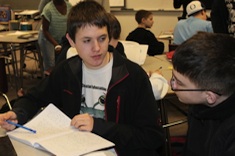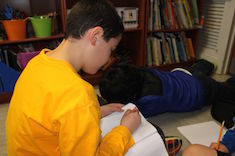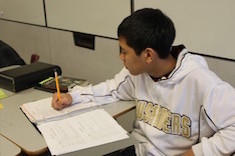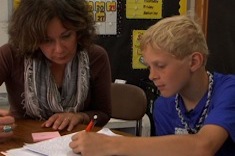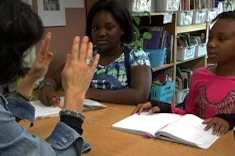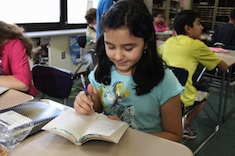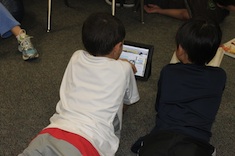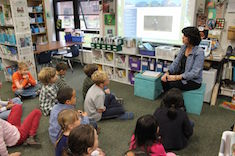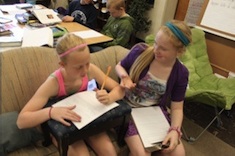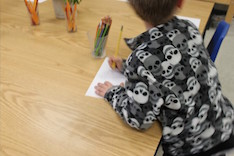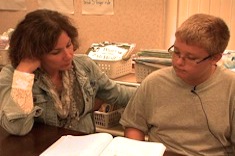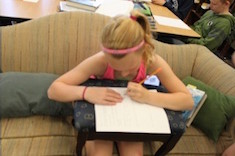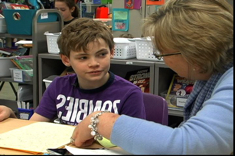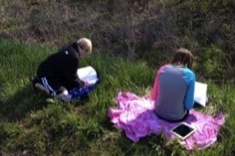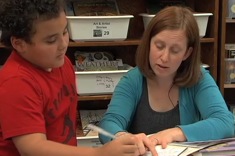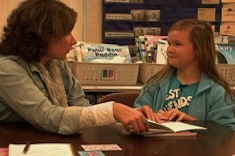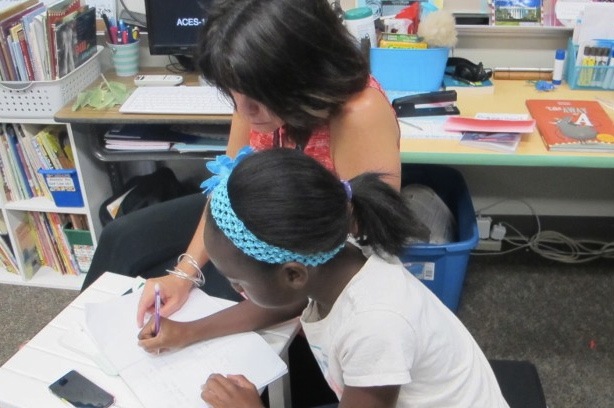Teaching Writing
Everyone who writes for Choice Literacy loves teaching writing, because we all write ourselves. We know it is "hard fun," as Donald Murray famously said—exasperating and exhilarating at the same time. The writing workshops you will read about here and see in our videos are busy, noisy, vibrant places. And most days, we wouldn't want to be anywhere else than in the midst of 'em! Here is where you'll find our latest discoveries, insights, and occasional boneheaded mistakes in teaching writing.
Latest Content
Time for What Matters
Gretchen Schroeder has only 42 minutes with her high school students each day. She explains how she establishes priorities.
Building Stamina in Middle School Writers
Carly Ullmer finds herself wasting a lot of time because of interruptions during student conferences, so she makes building stamina in her middle school students a priority.
The Intersection of Social Studies and Language Arts
Melanie Meehan writes about how teachers in her state are dealing with the time-crunch issue in social studies instruction by naturally integrating more social studies into the language arts program.
Risk and All
Tom Romano meets with Kacie, a student writing about an experience that shames her. He ponders the importance of facing the darkest parts of our experiences when we write. This is an exclusive excerpt from Tom's new book, Write What Matters.
Exploring the Writing Process
Dana Murphy considers the differences between authentic writing processes and what we teach in schools.
Debating How to Begin Stories
Melanie Meehan shares a minilesson using student writing as a model for experimenting with leads.
Conferring Over “Finished” Writing
Ruth Ayres challenges Grant to add paragraphs to his “finished” piece.
Owl Research Brainstorming: Partner Work
Andrea Smith’s fourth graders are working on an Owl Research project that integrates reading, writing, talking, listening, and content literacy.
Getting Mentor Texts in Students’ Hands
Jillian Heise discovers that her students need more access to the mentor texts she reads aloud, so she develops strategies to get them to students.
Mentor Texts and Memoir Writing
Gretchen Schroeder finds one mentor text has many uses as her high school students explore memoir writing.
What I Learned About Teaching Writing from My Trainer
Jodi Mahoney applies principles from one process to another in comparing writing and working out with a trainer.
Student Writing, Filters, and Social Media
Ruth Ayres explains why filtering is one of the most important concepts writers need to understand in this social media age, and she shares a simple lesson and chart for teaching students how filtering works.
Making Home Connections While Conferring
Ruth Ayres meets with Zoey, a quiet writer who is drawn into the conversation through family stories and a mentor text with vivid illustrations.
Engaging a Room Full of Third Graders
Melanie Meehan works with a third-grade teacher to rouse interest from a class of compliant students who lack engagement.
Ways into Personal Narratives
Katherine Sokolowski describes some Ways into Personal Narratives that use visual tools to build the home/school connection and stronger prewriting skills.
Invitations for Narrative Writing
Kim Campbell suggests activities and prompts to energize narrative writing with teens.
The Morning Story
Shari Frost encourages teachers to reconsider “the morning story” routine, a rote copying activity still prevalent in many primary classrooms. Shari offers some fun and practical alternatives.
A Thesis Statement: Conferring with Connor
Ruth Ayres confers with sixth grader Connor about constructing a thesis statement.
Moving Beyond Bed-to-Bed Stories in First Grade
Katrina Edwards moves her first graders from writing "bed-to-bed" stories early in the year with a mentor text and writing activity that promotes self-discipline and a growth mindset.
Resources for Quick-Writes
Katherine Sokolowski shares some of her favorite resources to jumpstart student interest in writing.
Back to Basics: Choice
Ruth Ayres explores the boundaries of student options in writing workshops.
From Strengths to Revision: Conferring with Connor
Karen Terlecky confers with fifth-grade Connor about his writing, demonstrating the routine of celebrating strengths first, and then making suggestions of new techniques to try.
Stories from Illustrations: Conferring with Kendall
Ruth Ayres draws out the story-writing possibilities with first-grader Kendall by conferring over her illustrations.
Figuring Out Social Media Together
Ruth Ayres finds storytelling is at the heart of social media, and describes how teachers and students might work together to find a place for social media in classrooms.
NaNoWriMo with Students
National Novel Writing Month (NaNoWriMo) is coming up in November, and it’s a wonderful opportunity for sustained writing and linking students with writers across the web. Katherine Sokolowski shares how it works, as well as tips for getting started.
A Fiction Writing Field Trip
Katherine Sokolowski’s students love writing fiction, but their skills don’t match their enthusiasm. A field trip helps bridge that gap.
Restarting a Writing Draft in Fourth Grade
Beth Lawson confers with Michael, a fourth-grade writer who struggles with focus and basic conventions.
“How Can I Help?” Conference
Ruth Ayres helps a fourth grader reflect on whether she is finished with her personal narrative, and how Ruth might assist her.
Data That Matters
What information is gathered by a teacher sitting in a rocking chair quietly watching her students? Christy Rush-Levine discovers it is plenty.
Staying True to Best Practices with Required Resources
Are you required to use a reading or writing program that goes against your beliefs about teaching and learning? Gigi McAllister has suggestions for holding onto your beliefs and sanity.
Browse Content By
Type
Category
- Assessment Tools
- Big Fresh Archives
- Booklists
- Choice Numeracy
- Classroom Design
- Common Core
- Community Building
- Conferring
- Content Literacy
- Digital Literacy
- English Language Learners
- Equity
- Family Relations
- Free Samples
- Guiding Groups
- Leadership
- Literacy Coaches
- Mentor Texts
- Minilessons
- New Teacher Mentors
- Podcasts
- Poetry
- Quote Collections
- Reading Strategies
- Self Care
- Struggling and Striving Learners
- Talking and Listening
- Teacher Study Groups
- Teaching Reading
- Teaching Writing
- Word Study and Vocabulary
Author
- Melissa Quimby
- Nawal Qarooni
- Gwen Blumberg
- Julie Cox
- The Lead Learners
- Hannah Tills
- Josie Stewart
- Ruth Metcalfe
- Mallory Messenger
- Becca Burk
- Jodie Bailey
- Vivian Chen
- Mary Brower
- Tiffany Abbott Fuller
- Stephanie Affinito
- Ruth Ayres
- Leigh Anne Eck
- Heather Fisher
- Shari Frost
- Julie Johnson
- Suzy Kaback
- Gigi McAllister
- Shirl McPhillips
- Melanie Meehan
- Cathy Mere
- Debbie Miller
- Tara Barnett and Kate Mills
- Tammy Mulligan
- Dana Murphy
- Bitsy Parks
- David Pittman
- Brenda Power
- Heather Rader
- Matt Renwick
- Mandy Robek
- Christy Rush-Levine
- Gretchen Schroeder
- Jen Schwanke
- Brian Sepe
- Katherine Sokolowski
- Stella Villalba
- Jennifer Vincent
Grade Level
Choice Literacy Membership
Articles
Get full access to all Choice Literacy article content
Videos
Get full access to all Choice Literacy video content
Courses
Access Choice Literacy course curriculum and training

